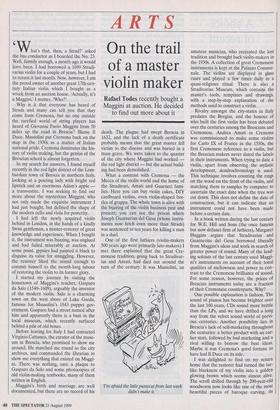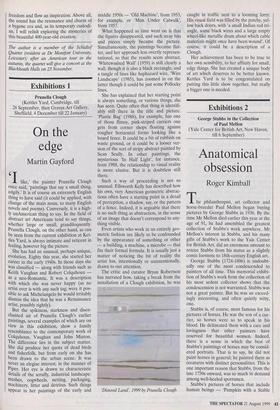ARTS
On the trail of a master violin maker
Rafael Todes recently bought a Maggini at auction. He decided to find out more about it What's that, then, a Strad?' asked the bus conductor as I boarded the No. 23. Well, funnily enough, a month ago it would have been. I had borrowed a 1699 Stradi- varius violin for a couple of years, but I had to return it last month. Now, however, I am the proud owner of another great 17th-cen- tury Italian violin which I bought as a wreck from an auction house. 'Actually, it's a Maggini,' I mutter. 'Who?'
Why is it that everyone has heard of Strads and many can tell you that they come from Cremona, but no one outside the rarefied world of string players has heard of Giovanni Paolo Maggini from 50 miles up the road in Brescia? Blame II Duce. Mussolini put Cremona back on the map in the 1930s as a matter of Italian national pride. Cremona dominates the his- tory of violin making, but the genius of the Brescian school is almost forgotten.
In my search for answers, I found myself recently in the red light district of the Lom- bardian town of Brescia in northern Italy, looking at a pouting lady with bright red lipstick and an enormous Adam's apple — a transvestite. I was seeking to find out more about the mysterious Maggini, who not only made the exquisite instrument I had just bought, but defined the shape of the modern cello and viola for posterity.
I had left the newly acquired violin behind in London, in the hands of a kindly Swiss gentleman, a master-restorer of great knowledge and experience. When I bought it, the instrument was buzzing, was unglued and had failed miserably at auction. At some point, gypsies had painted it black to disguise its value for smuggling. However, the restorer liked the sound enough to commit himself to the month-long labour of restoring the violin to its former glory.
I started my journey by visiting the hometown of Maggini's teacher, Gasparo da Salo (1540-1609), arguably the inventor of the modern violin. Salo is a charming town on the west shore of Lake Garda, famous for Mussolini's 1943 puppet gov- ernment. Gasparo had a street named after him and apparently there is a bust in the local museum, which recently surfaced behind a pile of old boxes.
Before leaving for Italy I had contacted Virginio Cattaneo, the curator of the muse- um in Brescia, who promised to show me around. He marched me round to the city archives, and commanded the librarian to show me everything that existed on Maggi- ni. There was nothing, save a plaque to Gasparo da Salo and some photocopies of old violin-making textbooks, many of them written in English.
Maggini's birth and marriage are well documented, but there are no record of his death. The plague had swept Brescia in 1632, and the lack of a death certificate probably means that the great master fell victim to the disease and was buried in a mass grave. We were taken to the quarter of the city where Maggini had worked the red light district — but the actual build- ing had been demolished.
What a contrast with Cremona — the Mecca of the violin world and the home of the Stradivari, Amati and Guarneri fami- lies. Here you can buy violin cakes, DIY cardboard violins, even violin-shaped bot- tles of grappa. The whole town is alive with the buzzing of the violin business past and present; you can see the prison where Joseph Guarnerius del Gesu (whose instru- ments now fetch even more than Strads) was sentenced to ten years for killing a man in a duel.
One of the first luthiers (violin-makers 500 years ago were primarily lute-makers) I met there explained that the great Cre- monese tradition, going back to Stradivar- ius and Amati, had died out around the turn of the century. It was Mussolini, an I'm afraid the little pussycat from last week didn't make it.' amateur musician, who recreated the lost tradition and brought back violin-makers in the 1930s. A collection of great Cremonese instruments is kept at the Palazzo Commu- nale. The violins are displayed in glass cases and played a few times daily in a quasi-religious ritual. There is also a Stradivarius Museum, which contains the master's tools, templates and drawings, with a step-by-step explanation of the methods used to construct a violin.
Rivalry amongst the city-states in Italy predates the Borgias, and the honour of who built the first violin has been debated over the centuries among the Brescians and Cremonese. Andrea Amati in Cremona was commissioned to make some violins for Carlo IX of France in the 1550s, the first Cremonese reference to a violin, but the Brescian makers never dated the labels in their instruments. When trying to date a violin, apart from observing the stylistic development, dendrochronology is used. This technique involves counting the rings on the wood on the front of the violin, and matching them to samples by computer to ascertain the exact date when the tree was cut down. This does not define the date of construction, but it can indicate that an instrument could not have been made before a certain date.
In a book written during the last century for W.E. Hill and Sons (the once famous but now defunct firm of luthiers), Margaret Huggins argues that Stradivarius and Guarnerius del Gesu borrowed liberally from Maggini's ideas and work in search of greater power of sound. Many of the lead- ing soloists of the last century used Maggi- ni's instruments on account of their tonal qualities of mellowness and power in con- trast to the Cremonese brilliance of sound. For some reason, however, the prices of Brescian instruments today are a fraction of their Cremonese counterparts. Why?
One possible explanation is fashion. The sound of pianos has become brighter over the last 100 years, CDs sound more brittle than the LPs, and we have drifted a long way from the velvet sound world of previ- ous centuries. Another possibility lies in Brescia's lack of self-marketing throughout the centuries: a better product with an ear- lier start, followed by bad marketing and a rival willing to borrow the best ideas. Maybe it was Cremona's good fortune to have had II Duce on its side.
I was delighted to find on my return home that the restorer had turned the tar- like blackness of my violin into a golden glowing brown which seems almost alive. The scroll drilled through by 200-year-old woodworm now looks like one of the most beautiful pieces of baroque carving, its freedom and flow an inspiration. Above all, the sound has the resonance and charm of a bygone era and, as its temporary custodi- an, I will relish exploring the mysteries of this beautiful 400-year-old creation.
The author is a member of the Schidlof Quartet (resident at De Montfort University, Leicester); after an American tour in the autumn, the quartet will give a concert at the Blackheath Halls on 23 November.



























































 Previous page
Previous page